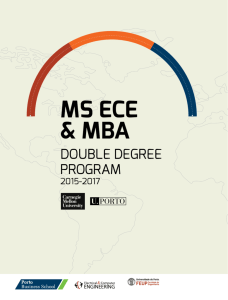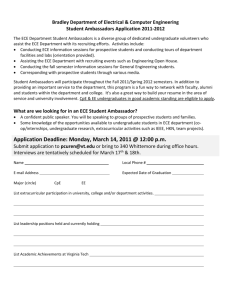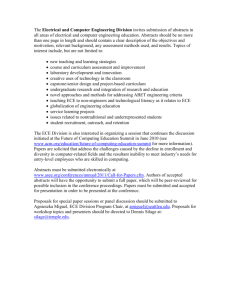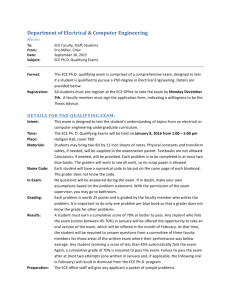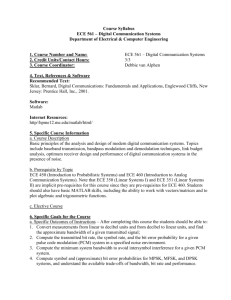ECE-492 Course Pamphlet - the GMU ECE Department
advertisement
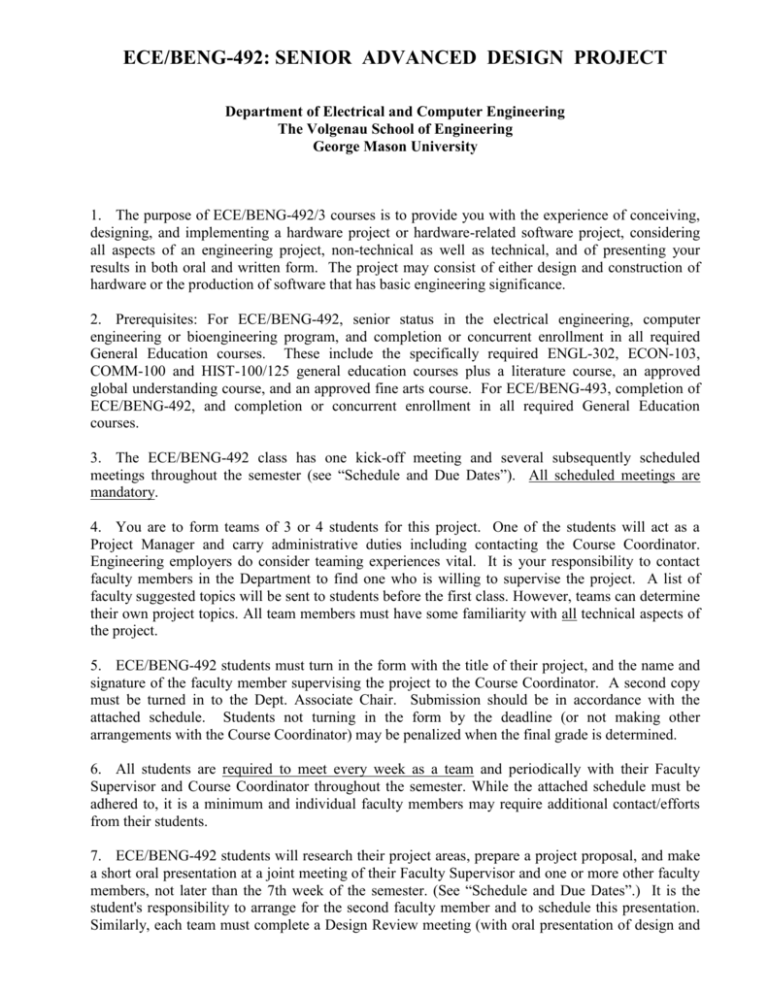
ECE/BENG-492: SENIOR ADVANCED DESIGN PROJECT Department of Electrical and Computer Engineering The Volgenau School of Engineering George Mason University 1. The purpose of ECE/BENG-492/3 courses is to provide you with the experience of conceiving, designing, and implementing a hardware project or hardware-related software project, considering all aspects of an engineering project, non-technical as well as technical, and of presenting your results in both oral and written form. The project may consist of either design and construction of hardware or the production of software that has basic engineering significance. 2. Prerequisites: For ECE/BENG-492, senior status in the electrical engineering, computer engineering or bioengineering program, and completion or concurrent enrollment in all required General Education courses. These include the specifically required ENGL-302, ECON-103, COMM-100 and HIST-100/125 general education courses plus a literature course, an approved global understanding course, and an approved fine arts course. For ECE/BENG-493, completion of ECE/BENG-492, and completion or concurrent enrollment in all required General Education courses. 3. The ECE/BENG-492 class has one kick-off meeting and several subsequently scheduled meetings throughout the semester (see “Schedule and Due Dates”). All scheduled meetings are mandatory. 4. You are to form teams of 3 or 4 students for this project. One of the students will act as a Project Manager and carry administrative duties including contacting the Course Coordinator. Engineering employers do consider teaming experiences vital. It is your responsibility to contact faculty members in the Department to find one who is willing to supervise the project. A list of faculty suggested topics will be sent to students before the first class. However, teams can determine their own project topics. All team members must have some familiarity with all technical aspects of the project. 5. ECE/BENG-492 students must turn in the form with the title of their project, and the name and signature of the faculty member supervising the project to the Course Coordinator. A second copy must be turned in to the Dept. Associate Chair. Submission should be in accordance with the attached schedule. Students not turning in the form by the deadline (or not making other arrangements with the Course Coordinator) may be penalized when the final grade is determined. 6. All students are required to meet every week as a team and periodically with their Faculty Supervisor and Course Coordinator throughout the semester. While the attached schedule must be adhered to, it is a minimum and individual faculty members may require additional contact/efforts from their students. 7. ECE/BENG-492 students will research their project areas, prepare a project proposal, and make a short oral presentation at a joint meeting of their Faculty Supervisor and one or more other faculty members, not later than the 7th week of the semester. (See “Schedule and Due Dates”.) It is the student's responsibility to arrange for the second faculty member and to schedule this presentation. Similarly, each team must complete a Design Review meeting (with oral presentation of design and prototyping progress) with their Faculty Supervisor and one or more other faculty members, not later than the 11th week of the semester. Proposal and design review documents must be submitted accordingly. 8. Written and well-documented Design Document is due in the 14th week. Do not miss the deadlines and deliver the above documents/reports according to the distribution list included on the “Schedule and Due Dates” sheet. Also, the Document Tracking Form is due to be delivered to the Course Coordinator and its copy to the Associate Chair in the 14th week. The final delivery must be made in the form of a single envelope containing all required documents. Subsequent delivery of missing documents will not be accepted. 9. Team evaluation forms are due twice a semester. Each form must be completed individually. This is not a “group’ or “consensus” evaluation. 10. Teams are required to start prototyping in the second half of the semester (in parallel with system design). This prototyping is expected to be limited to acquiring and testing key parts/components. Modeling and simulation is frequently required at this stage. This early hands-on experience with key components is essential to the success of your project and has an influence on the final grade for ECE/BENG-492. Progress report from early prototyping must be included in the Design Document. 11. ECE/BENG-492 requested documentation (Proposal, Design Review Slides, and Design Document) must be prepared in a narrative form as professional documents. The following are recommended formats for these documents: Proposal 1. Cover page. 2. Executive summary (1/2 - 1 page). 3. Problem statement as an identification of need (1-2 pages). 4. Approach - including problem analysis and requirements definition (2-4 pages). 5. Preliminary design (3-5 pages). 6. Preliminary experimentation plan (1-2 pages). 7. Preliminary list and brief description of tasks and allocation of responsibilities (1-2 pages). Design Review Slides 1. Cover page. 2. Short review of identification of need and requirements definition. 3. Design architecture (Level-0 and Level-1). 4. Preliminary detail design (Level-2). 5. Preliminary system models used in your design (State diagram, data flow diagram, etc.) 6. List of prototyping activities and progress discussion. 7. Problems/surprises you encountered. Design Document 1. Cover page. 2. Summary of motivation, identification of need, and requirements definition. 3. System design/architecture – system decomposition and interfaces. 4. Detail design – (a) defined to the circuit schematic level, or (b) flow diagrams with identification of subroutines and main parameters for simulation projects. 5. Prototyping progress report – what was built/experimented with, etc. 6. Experimentation plan and selection of evaluation criteria. 7. List and description of tasks and their decomposition into subtasks with allocation of responsibilities. 8. Schedule and milestones. 12. Project issues that must be addressed during the Project and documented in the ECE/BENG-492 Design Document and ECE/BENG-493 Final Project Report: a. Reason for the project. Who would benefit, how would they benefit and what would the benefit be? What could be the impact of success? Engineers solve problems to the benefit of humanity. b. Potential use of the project. Could the project lead to a marketable product, service or function? Who might the users or purchasers of this product/service/function be? Would the product/service/function serve only local needs or could it be applicable on a wider, potentially global, range of users? c. Cost figures for the project. Include parts, rough assembly/coding time/costs, student time spent on design and implementation of the project, and (based on the student time spent) estimated cost of design and this first prototype. d. Alternatives to the implemented design that could impact costs and effects on resources use and the environment and community. Alternatives to the chosen design solution. e. Maintainability/maintenance of the final design solution. (Note, software must be maintained as well as hardware.) f. Retirement, replacement, or disposal of the project at the end of its “lifetime”, i.e. environmental disposal of parts such as batteries, recycleability of parts at time of disposal, documentation needed to allow a replacement or upgrade to be designed. g. The ECE-493 Final Report must include the ECE/BENG-492 Proposal as an Appendix A, and Design Document as an Appendix B. Lack of clear and complete discussion of these aspects will result in a grade penalty. References, personal communications, web based sources, etc should be properly cited. 13. The ECE/BENG-492/493 sequence fulfills the George Mason General Education "Synthesis" course requirement in the electrical engineering, computer engineering and bioengineering majors. The Goal of the Synthesis course is that: “Students will engage in the connection of meaning and the synthesis of knowledge. Synthesis courses may link issues in the student's major to wider intellectual and community concerns. This course may be a capstone course in the major. This component also requires students to demonstrate advanced skills in oral and written presentation. This demonstration will build not only on the communication and synthesis experience of the third year but also on the recurrent attention to these skills in the whole General Education program from the foundation courses onward.” ECEBENG-492/493 satisfies this requirement through the several "non_technical" aspects of the project required in the previous paragraphs. It is the student's responsibility to address these issues fully. Failure to satisfy this aspect of the project may result in the student not being approved to graduate. 14. The ECE/BENG-492/493 sequence fulfills the Writing_Intensive requirement in the electrical engineering, computer engineering and bioengineering majors. It does so through the periodic activity reports, the ECE/BENG-492 Design Document and the ECE/BENG-493 Final Report. The Project Plan and Final Report will be completed through a draft/feedback/revision process. Make sure you submit appropriate draft document early enough that your Faculty Supervisor has time to review and provide comments back to you. Failure to satisfy this aspect of the project may result in the student not being approved to graduate. The due dates for the periodic activity reports, the Project Plan and the Final Report are shown in the Due Date Schedule for ECE/BENG-492/493 Documentation. The "flow" of project documents to your Faculty Supervisor and resultant feedback is tracked. It is the student's responsibility to meet the scheduled deadlines, to obtain all appropriate signatures, and to deliver the signature sheet. 15. Faculty supervising each project will propose a grade for a project and individual team members. The Course Coordinator may also be involved in decisions on grades. However, the final grade is issued by the ECE Department. Each group member will be graded according to his/her contribution to the design and implementation of the project. Not meeting specified deadlines and required submissions or delivering documents in poor quality will adversely affect the final grades of all team members. The best projects will qualify for an extra grade upside adjustment. Project Title Form ECE/BENG-492 SENIOR ADVANCED DESIGN PROJECT This form must be completed and returned to the Course Coordinator by 5:00 p.m. on Friday of the third week of the semester. (See “Schedule and Due Dates”.) The faculty member supervising this project must sign this form before it is turned in. A second copy must be turned in to the Dept. Associate Chair by this date as well. Email will be used to contact you during this course. You must check it regularly. If you do not respond to an email request related to ECE/BENG-492/493 the entire project team will be "adversely rewarded" when the final grade is determined. TYPE carefully and clearly (particularly email addresses), all information requested below. Use only GMU email addresses. STUDENT NAME(s): email address email address email address email address email address TITLE OF PROJECT: Faculty Supervisor Name: Faculty Signature: Date: COVER PAGE FORMAT ECE-492 (or BENG-492) DESIGN DOCUMENT TITLE OF PROJECT ABSTRACT/ SUMMARY ( ~3/4 page) Team Members Date of Submission Faculty Supervisor Name ECE/BENG-492 Oral Proposal Presentation Evaluation Please bring this form to your presentation, ask at least two ECE faculty to attend and submit this form to the Course Coordinator. Project Title: ____________________________________________________ Date: __________ Team members: ____________________________ _____________________________ ____________________________ _____________________________ 1 = Strongly Disagree 2 = Disagree 3 = Agree 4 =Strongly Agree 1. Presentation was clear and technically explained the project well 1 2 3 4 1 2 3 4 1 2 3 4 4. The suggested solutions are appropriate (Will the proposed approach solve the 1 problem or need that outlined? Did the team consider alternative solutions?) 2 3 4 1 2 3 4 1 2 3 4 7. It is economically viable (or will it be simply too expensive to prototype and/or build in production volume?) 1 2 3 4 8. The project has a high probability of success 1 2 3 4 9. The project has a high learning value for the team members 1 2 3 4 2. Presentation was well done in a non-technical sense (i.e., appropriate visual aids, easy to follow organization, voice clear and loud enough, no distracting mannerisms.) 3. The Problem/Need/Requirement Statement was clear and well presented 5. The solution is technically feasible (Is it possible to achieve it with the current team members and within the time frame of ECE492/493? Is it too complicated, too simple or not practical?) 6. The project exploits the art of technology (It reaches over and brings together different technologies – multi-disciplinary aspect? Does it add something to the art? Or simply is it a rehash of an existing project or product?) CERTIFICATION: Team is promoted to the detail design phase (please mark one) Team needs to modify proposal and present it again by ____________ Comments: Faculty Reviewer: ____________________________________________ ECE/BENG-492 Design Review Evaluation Please bring this form to your presentation, ask at least two ECE faculty to attend and submit this form to the Course Coordinator. Project Title: ____________________________________________________ Date: __________ Team members: ____________________________ _____________________________ ____________________________ _____________________________ 1 = Strongly Disagree 2 = Disagree 3 = Agree 4 =Strongly Agree 1. Presentation was clear and technically explained the project well. 1 2 3 4 1 2 3 4 3. System architecture, functional decomposition/allocation, and interfacing between modules were explained well 1 2 3 4 4. The team showed and discussed preliminary circuits, algorithms, etc. (all discussed at detail level.) 1 2 3 4 5. The team showed and discussed preliminary system model(s) (i.e., state diagram, flow chart, or other) 1 2 3 4 6. Early prototyping is underway 1 2 3 4 7. All team members demonstrate deep understanding of their project. All questions and concerns were answered/addressed well. 1 2 3 4 8. Design load is adequately distributed across all team members (i.e., every member contributes substantially to the design at system/circuit/algorithm level) 1 2 3 4 9. The design effort in on track 1 2 3 4 2. Presentation was well done in a non-technical sense (i.e., appropriate visual aids, easy to follow organization, voice clear and loud enough, no distracting mannerisms.) CERTIFICATION: Design effort is at or above satisfactory level (please mark one) Design effort is not satisfactory and the team is warned of a possible failure to advance to ECE-493 Comments: Faculty Reviewer: ____________________________________________ ECE/BENG-492 Weekly Task Allocation/Delivery This form must be completed by the PM during each team meeting. Filled forms must be kept by the PM and submitted to the FS/CC upon request. Project Title: _____________________________________________ Meeting Date: __________ Team members present: _______________________________________________________________ Team members absent: _______________________________________________________________ Task progress report for the last week effort: Line# Task description Team member assigned Progress 0%-100% Delivery proof Task allocation for the next week: Line# Task description Team member assigned PM name: _____________________ ___________ Date Student Name Senior Design Project Team Evaluation ECE/BENG-492 This should be done individually. It’s an honor code violation to have any team orders, arrangements/guidance regarding individual evaluations. Project Title: Please list each team member (yourself included) and indicate to what extent each member contributed (as a team member) to the progress/success/completion of the project. You have to use approximate percent (should add up to about 100%) to express their contribution. Team Member Comments: Contribution in % Specific Contributions Document Tracking Form GEORGE MASON UNIVERSITY ELECTRICAL AND COMPUTER ENGINEERING DEPARTMENT ECE/BENG-492 Senior Advanced Design Project Student Name(s): Project Title: Faculty Supervisor: 1. Week 6: Draft Proposal delivery. Faculty Signature Date Faculty Signature Date Faculty Signature Date Draft Proposal returned to students. 2. Week 7: Proposal Oral Presentation and Proposal delivery. Second Faculty Member Signature 3. Week 11: Design Review Oral Presentation and Design Review Slides delivery. Faculty Signature Date Second Faculty Member Signature 4. Week 12: Draft Design Document and Prototyping Progress Report delivery. Faculty Signature Date Faculty Signature Date Draft Design Document returned to students. 5. Week 14: Design Document delivery. No need for signature

